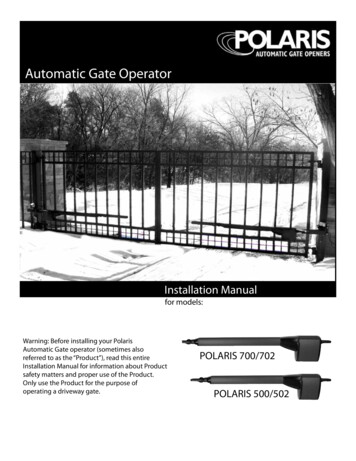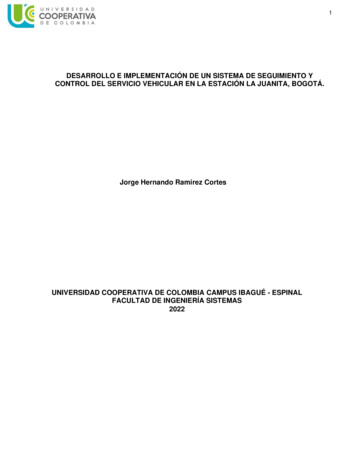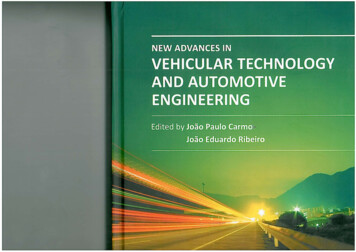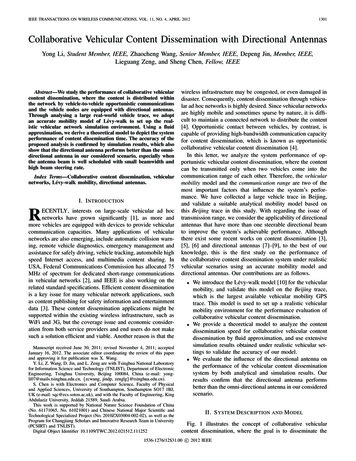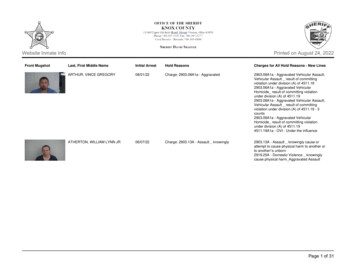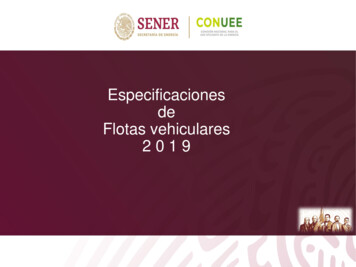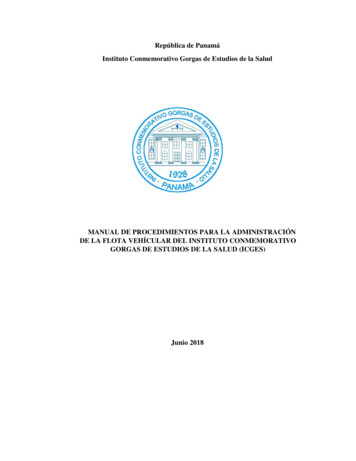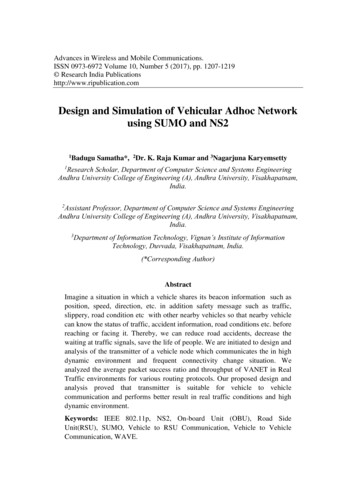
Transcription
Advances in Wireless and Mobile Communications.ISSN 0973-6972 Volume 10, Number 5 (2017), pp. 1207-1219 Research India Publicationshttp://www.ripublication.comDesign and Simulation of Vehicular Adhoc Networkusing SUMO and NS21BaduguSamatha*, 2Dr. K. Raja Kumar and 3Nagarjuna Karyemsetty1Research Scholar, Department of Computer Science and Systems EngineeringAndhra University College of Engineering (A), Andhra University, Visakhapatnam,India.2Assistant Professor, Department of Computer Science and Systems EngineeringAndhra University College of Engineering (A), Andhra University, Visakhapatnam,India.3Department of Information Technology, Vignan’s Institute of InformationTechnology, Duvvada, Visakhapatnam, India.(*Corresponding Author)AbstractImagine a situation in which a vehicle shares its beacon information such asposition, speed, direction, etc. in addition safety message such as traffic,slippery, road condition etc with other nearby vehicles so that nearby vehiclecan know the status of traffic, accident information, road conditions etc. beforereaching or facing it. Thereby, we can reduce road accidents, decrease thewaiting at traffic signals, save the life of people. We are initiated to design andanalysis of the transmitter of a vehicle node which communicates the in highdynamic environment and frequent connectivity change situation. Weanalyzed the average packet success ratio and throughput of VANET in RealTraffic environments for various routing protocols. Our proposed design andanalysis proved that transmitter is suitable for vehicle to vehiclecommunication and performs better result in real traffic conditions and highdynamic environment.Keywords: IEEE 802.11p, NS2, On-board Unit (OBU), Road SideUnit(RSU), SUMO, Vehicle to RSU Communication, Vehicle to VehicleCommunication, WAVE.
1208Badugu Samatha, Dr. K. Raja Kumar and Nagarjuna Karyemsetty1. INTRODUCTIONAdvances in ad hoc wireless technology and enhancement in intelligence of humanthought process, give rise to the emergence of special and unique category of wirelesstechnology called Vehicular adhoc network (VANET) and also Institute of Electricaland Electronics Engineers (IEEE) standards for Wireless Access in VehicularEnvironment (WAVE) is presently represented as the most advanced and emergingtechnology for vehicular wireless networks. It goal is to support inter vehiclecommunication, reliable & safe communication in a transport or vehicularenvironment. Vehicular adhoc network (VANET) is subset of wireless adhoccommunication in which vehicles acts as node. Every vehicle is able to communicatewith other nearby vehicle by forming adhoc network. VANET is uniquelydifferentiated based on two special & unique characteristics of wireless networks suchas high dynamic connectivity in network and frequently change of network topology.These two properties separate the VANET from other networks such as MANET etc.the increased utilization of vehicles on roads, also increases the road accidents, unsafejourneys and polluted environment etc. and these things motivated us to initiate thiswork. To assure the safe journey of passengers, drivers and provide the comfortable &easy driving environment, different messages for different requirement arecommunicated to nearby vehicles called the inter-vehicle communications.Every vehicle in these networks is integrated with VANET transceivers or OBU tocommunicate with other vehicles to form a special class of wireless adhoc networks,known as vehicular ad hoc networks or VANETs [1]. Every vehicle node is equippedwith an network interface unit called on-board unit (OBU) which consists ofcommunication module, processing module and display unit. With the help ofcommunication module in OBU, each vehicle node able to communicate with othernearby vehicle node (OBU). Vehicular communication system is specially characterized by its high speed of vehicular nodes, wide range of relative speeds amongvehicles nodes and frequently changes in network topology. In VANETs, vehiclenodes tend to move in an organized and pre specified mobility (such as streets lane,four road junction etc.), thus, low level technical issues like energy utilization and andesign of antenna etc. are not significant technical issues [2] in these types ofnetworks. Vehicular system may consist of Road Side Unit (RSU) in addition toOBU, which is a network interface device located in the moving vehicles and connected to both in adhoc mode and infrastructure mode. In adhoc mode, every vehiclenode or OBU is able to communicate with other vehicle node or OBU. Ininfrastructure mode, every vehicle node or OBU is communicate with Road Side Unit(RSU), which can be described as a device installed in the road infrastructure (suchas. Light pole and road signs) that able connect to the moving vehicle to collectvehicle messages at base level which in turn is connected to the core network [3] toshare and store data. Vehicular network have two main types of communications. One
Design and Simulation of Vehicular Adhoc Network using SUMO and NS21209main type of communication is vehicle to vehicle or OBU to OBU and second isVehicle to RSU or OBU to RSU communication as shown in Figure 1.Fig. 1. Vehicular Adhoc Network ( OBU-OBU & OBU-RSU)Figure 1 shows the vehicular network formed among the OBUs or vehicle nodes,OBU to RSU and RSU to RSU. One OBU. In this paper, we provide two keycontributions pertaining to multi-channel VANETs. First, we generated the mobilitydata from real time GPS OpenStreetMap with help of traffic generator. Second, weintegrated real time traffics generated from SUMO into ns2 simulator.2. RELATED WORKAuthors in [3] and [4] utilized the real maps imported from Google maps, and vehiclemobility patterns are constrained or restricted to a real road topology from maps, butthe source node and destination nodes are random generated. In practical or realsituations, the city's traffic flow will be adapted with respect to time i.e during officehours, during odd timings and special events etc. and it is not completely generatedby random. A real traffic generator has been used in [5], but it does not provide thetraffic lights, road maximum speed and other details. Authors in [6] integrate VISSIMwith NS2 and achieve an agreement under real traffic conditions, but VISSIM is notopen source, so this method is not widely used.The remainder of this paper is organized as follows. Section 2 summarizes theexisting work done or related work in VANET. Real time traffic generation andsimulation using SUMO is presented in Section 3. VANET simulation using NS2simulator and methodology used is summarized in Section 4. Simulation results aredescribed in section 5. Section 6 concludes the paper.
1210Badugu Samatha, Dr. K. Raja Kumar and Nagarjuna Karyemsetty3. REAL TIME TRAFFIC GENERATIONAs modeling & simulation approaches plays a two important & increasinglysignificant roles in VANET research in current situations, many efforts have beentaken to dedicated to the network simulation of real vehicle traffic scenarios.Deployment of hardware to form network scenario requires minimum of five nodesand become expensive in developing countries like India. We initiatedimplementation of VANET network with real time traffic. As we said above, thistraffic was generated from OpenStreetMap which contains latitude, longitude orposition of vehicle etc. and step by step process is given below.Real Traffic Generator (SUMO)[8]To design and implementation of VANET in urban environment, we downloaded theVisakhapatnam city OSM file from OpenStreetMap [10] and created a real time roadtraffic scenario using SUMO 0.22 simulator with a real traffic as shown in belowfigure 2 and detailed view of communication is shown figure 3. The mobility oftraffic data is generated in SUMO trace exporter, that will be exported to NS2simulator which is used as vehicular network simulator for analyzing the VANETperformance.By using sumo commands such as netconvert and polyconvert, we are able to convertthe open street map OSM data into configuration (cfg) file. These configuration filesare used to store information and settings. we can also generate trace files which is avery important step in order to create a network scenario for the network simulatorwhich is NS 2 in our case. Generation of trace files can be done in different ways suchas using sumo trace exporter, & using MOVES etc. Because SUMO has an inbuiltutility to generate trace files that comes in the default package in sumo itself (anyextra software components not required), we preferred the SUMO trace exporter. Thesumo package contains tools directory which contains exporter. We can use this eitherby using the newer command - Python Script or by using the traditional –jar file.It is a two-step process.Step1: Use SUMO, to create a traffic trace file using fcd output attribute as shownbelow:sumo -c My-scenario.sumo.cfg --fcd-output sumoTrace.xml.Step2: Convert the traffic data file into actual/destination trace file format. In ourcase, it is tcl script which is NS2 trace file. There will be three output files: mobilityfile, activity file and config file.
Design and Simulation of Vehicular Adhoc Network using SUMO and NS21211C:/traceExporter.py –fcd-input smpleTrace.xml –ns2mobility-output mobility.tclC:/traceExporter.py –fcd-input smpleTrace.xml –ns2activity-output activity.tclC/traceExporter.py –fcd-input smpleTrace.xml –ns2config-output config.tclThe above procedure shows creation of traffic files (tcl format) and was integratedinto Ns2 simulatorFig. 2. Visakhapatnam Traffic Simulation in SUMO 0.22The SUMO simulator is an open source and real time traffic simulation packageincluding net import and demand modeling components. SUMO helps to investigateseveral research topics in networks e.g. route analysis and traffic light methods andsimulating vehicular networks [1] Therefore the framework is used in differentprojects to simulate automatic driving or traffic management strategies. Few featuresof SUMO has, space-continuous and time-discrete vehicle movement, differentvehicle types, multi-lane streets with lane changing, different right-of-way rules,traffic lights, a fast open GL graphical user interface, manages networks with severaledges, fast execution speed, interoperability with other application at run-time,network-wide, edge-based, vehicle-based, and detector-based outputs, supportsperson-based inter-modal trips, high portability and high interoperability. HenceSUMO is more suitable and convenient for simulation of vehicular communication.
1212Badugu Samatha, Dr. K. Raja Kumar and Nagarjuna KaryemsettyFig. 3 Traffic at Maddilapalem junction in Visakhapatnam city.An experiment is conducted to implement and simulation of VANET. Experiment canbe of two types’ outdoor experiment and experiment using simulators. Before theimplementation of VANET in real World, Series of experiments should be carried outto test it. These experiments can be expensive and highly complex to inherit all kindsof situation. For this purpose software simulations can be implemented to eradicatesuch factors. In VANET, two types of simulation are required for smooth functioning,Network simulation and Traffic simulation. Network simulators such as NS2 [9] areused to evaluate the network protocols or say routing protocols for issues related tothe communication among vehicles, and application in a variety of conditions whereastraffic simulators are used for Traffic engineering and transportation.
Design and Simulation of Vehicular Adhoc Network using SUMO and NS212134. SUMO AND NS2 INTEGRATION FOR VANET SIMULATIONNetwork Simulator 2 (NS2) is a event based discrete network scenario simulationsoftware for various protocols in Internet systems and targeted primarily for researchand educational use [1]. NS2 is a research community accepted network simulator.Comparing with other well-known network simulation tools, NS2 has severaladvantages. The first & foremost one is, its code is open source, research communityaccepted and openness facilitates to modify the existing mechanism as per ourrequirements. The second one is its extendibility and stability. NS2 can support largesimulation scenario where the number of nodes can be up to 20000, making thesimulation results more realistic. The sequence of steps in integration of trafficsimulator and network simulator is shown below figure 4.Fig 4. Sequence diagram of flow of execution of VANET application
1214Badugu Samatha, Dr. K. Raja Kumar and Nagarjuna KaryemsettySimulation Setup and its ResultsTable 1: VANET Simulation ParametersParameterNetwork SimulatorTraffic SimulatorMap ModelRouting ProtocolTransport ProtocolNumber of VehiclesMinimum SpeedMaximum SpeedPropagation ModelSimulation timeModulationData RatesPacket SizeApplication TypeCode rateValueNS 2.34SUMO v0.22OSM(Visakhapatnam city)AODV,DSDV,DSRUDP,TCP10-1001 km/h60 km/hTwo ray ground, Nakagami50,100,150,200 sBPSK,QPSK,16QAM,64 QAM3-27 Mbps500,900 bytesCBR½, 2/3Simulation of VANETs with various parameters as shown in table 1, wasexperimented and observed behavior of network in different scenarios. For theperformance evaluation in IEEE 802.11p protocols with network density of 50 vehiclenodes in smart city environment, we created a road traffic scenario in SUMO v0.22(Simulation of Urban Mobility) with a traffic of 10 to 100 vehicles and integratedSUMO 0.22 with NS2 as shown in Figure 5. The traffic files are generated in SUMOtrace exporter, will be exported to NS2 2.34 [11] which is a network simulator foranalyzing the VANET performance using pre built-in or standard topology basedrouting protocols such as Adhoc On Demand Distance Vector (AODV), DistanceSource Routing (DSR), Destination-Sequenced Distance-Vector Routing (DSDV) asshown in Figure 5. The output of sumo simulator (traffic scenario ) file is loaded inns2 simulator to real time traffic simulation.
Design and Simulation of Vehicular Adhoc Network using SUMO and NS21215Fig. 5. Visakhapatnam Traffic Simulation in NS2Figure 5 shows the OBU nodes and RSU formed in vehicular network. Circle aroundthe each nodes indicates that the communication range of a node, a message passed tonearby OBU or RSU nodes. Even though OBU and RSU are differentiated in terms ofcomputation power, we considered both a same. In real time scenarios, RSU is morecomputation power than the OBU.5. PERFORMANCE EVALUATION AND RESULTSThe behavior or performance of VANET in various scenarios measured orperformance metrics considered, in terms of average packet delivery ration, averagethroughput and average end to end delay. The packet delivery ratio (PDR) iscalculated as the ratio of the number of data packets transmitted to the destinationsuccessfully is given by equation 1.Equation 1Where 𝑝𝑑𝑟 indicates packet delivery ratio, P𝑠 is the total number of packets sentbetween one source and one destination node and P𝑟 is the total number of packet
1216Badugu Samatha, Dr. K. Raja Kumar and Nagarjuna Karyemsettyreceived sucussfully. Network behavior or performance is determined by averagingthe packet delivery ratio among all nodes in the network and calculated as thefollowing equation 2.Equation 2PDRij is the packet delivery ration between source node i to destination node j(computed based on equation1) and Avg(PDR) is sum of all PDRs in network dividedby n where n is total number of node in VANET network gives the actual PDR ofVANET. Equation 2 is used to compute the average packet delivery ration ofVANET.Fig. 6. Packet Delivery Ratio in VANETThroughput of VANET is a measure of the amount of data transmitted from thesource vehicle to the destination vehicle in the Vehicular network in a unit period oftime (second) given by equation 3.Equation 3
Design and Simulation of Vehicular Adhoc Network using SUMO and NS21217where 𝑇hr is the throughput of the node i, N𝑏 is the number of bits transmitted fromsource to destination and 𝑡 is the time taken for transmission.Equation 4Average throughput of VANET is computed as sum of throughputs of all vehiclenodes successfully transmitted divided by n where n is total number vehicle nodes innetwork. Equation 4 is used to computed the average throughput of VANETFig. 7. Throughput in VANETEnd-to-end Delay is determined by the average time taken by a data packet to arrivein the destination in network and given by equation .Equation 5where 𝑒𝑒𝑑 is the end to end delay, 𝑎𝑡 is the arrival time of the data packet, 𝑠𝑡 is thesent time of the data packet and 𝑛𝑐 is the number of connections.Figure 6 and Figure 7 shows the packet delivery ratio and throughput respectively ofvehicular network.
Badugu Samatha, Dr. K. Raja Kumar and Nagarjuna Karyemsetty12186. CONCLUSIONThe overall objective of this paper is to evaluate behavior the vehicular network indifferent scenario. A detailed study made of the structure of the WAVE architecturefor VANETs. We subsequently created a set up with real traffic scenario ofVisakhapatnam city of various node densities which will help us to analyze theperformance metrics of the VANET (throughput, End to end delay, and packetdelivery). This scenario is implemented and evaluated using ns-2 network simulatorand SUMO traffic simulator. One of the most important points in the vehicularcommunication simulation is that the nature of vehicular communication is based onthe movement, so it is necessary to implement a realistic vehicular movement in thesimulation. In other words, all of the important parameters should be implementedaccurately in the VANET simulation. The main novelty of this paper is to implementthe key parameters of 802.11p standard in ns-2, and prepare the realistic vehicularmobility model by SUMO. Our analysis results shows that DSR routing protocolperforming the better in real time and dynamic environment as simulation timeincreases. Our future work is to provide security routing protocol in realistic anddynamic connection of VANETREFERENCES[1]IEEE, Abbas Jamalipour, Tarik Taleb, Member, IEEE, Ehssan Sakhaee,Student Member, Fellow, IEEE, Kazuo Hashimoto, Member, IEEE, Nei Kato,Senior Member, IEEE, and Yoshiaki Nemoto, Senior Member, IEEE, AStable Routing Protocol to Support ITS Services in VANET Networks, IEEETransactions on Vehicular Technology, Vol. 56, No. 6, November 2014, pp3337-3347.[2]Martin Mauve, Dieter Vollmer, Michael Kasemann and Hannes Hartenstein ,“A comparison of best routing protocol strategies in vehicular ad-hocnetworks,” TechRep. 3/2002, Universit at Mannheim, Mar 2013.[3]F. Li La Wan and Y. Wang, “Routing Protocols in vehicular ad hocnetworks(VANET): A survey,” IEEE Vehicular Technology Magazine, vol. 2,no. 2, pp. 12–22, Jun. 2014.[4]D. F. Choffnes, F. Bustamante, “An integrated mobility and traffic model forvehicular wireless networks,” Proceedings of the 2nd ACM internationalworkshop on Vehicular ad hoc networks. ACM 2015.[5]J. Harri, M. Fiore, F. Fethi, “VanetMobiSim: generating realistic mobilitypatterns for VANETs,” Proceedings of the 3rd international workshop onVehicular ad hoc net-works. ACM, 2016.
Design and Simulation of Vehicular Adhoc Network using SUMO and NS21219[6]K. Rama , K. Lakshmi , S.Manju Priya, K.Thilagam & A.Jeevarathnam“Comparison of Three Routing Algorithms based on Greedy for effectivePacket Forwarding in VANET”, Int. J. Computer Techology & Applications,Vol 3 (1), Jan-Feb 2013, pp-.146-151.[7]Mirko Stoffers, George Riley, "Comparing the ns-3 Propagation Models",MASCOTS, 2012, 2012 IEEE 20th International Symposium on Modelling,Analysis & Simulation of Computer and Telecommunication Systems(MASCOTS), 2012 IEEE 20th International Symposium on Modelling,Analysis & Simulation of Computer and Telecommunication Systems(MASCOTS) 2012, pp. 61-67, doi:10.1109/MASCOTS.2012.17.[8]SUMO, Simulation of Urban Mobility, 9883/16931 read-41000/[9]NS2, Network Simulator 2, http://www.nsnam.org.[10] OpenStreetMap, https://www.openstreetmap.org/[11] w.isi.edu/nsnam/ns/doc/node216.html, 2011.Available:[12] Mohammad Siraj, Soumen Kanrar, “Performance of Modeling wirelessnetworks in realistic environment”, International Journal of ComputerNetworks (IJCN), Volume (2): Issue (1), pp: 62-79.[13] T. S. Rappaport. Wireless communications, principles and practice, PrenticeHall, 2006.
1220Badugu Samatha, Dr. K. Raja Kumar and Nagarjuna Karyemsetty
Network Simulator 2 (NS2) is a event based discrete network scenario simulation software for various protocols in Internet systems and targeted primarily for research and educational use [1]. NS2 is a research community accepted network simulator. Comparing with other well-known network simulation tools, NS2 has several advantages.
